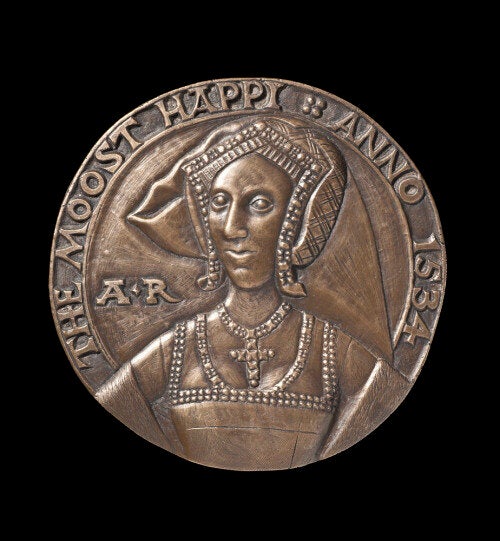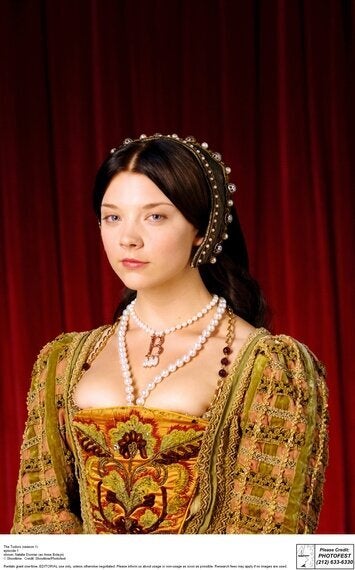Co-authored by Lucy Churchill
What did Anne Boleyn look like?
According to the distinguished historian Eric Ives, the Anne depicted on the reconstructed commemorative medal pictured below is "as close to the real Anne Boleyn as we shall ever be able to get." Made in 1534, the year after Henry VIII and Anne's marriage and the birth of their daughter Elizabeth, the original medal was cast while Anne was again pregnant, and celebrates a joyous time when it was confidently presumed that Anne would give birth to a son. That didn't happen-with fatal consequences for Anne. And while the medal-'The Moost Happi. Anno 1534'-somehow escaped Henry's revisionist rampage (he had all Anne's portraits destroyed when she was executed), the ensuing years did their own damage, obscuring one of the eyes, and flattening the nose. Now, after rigorous historical research and painstaking, meticulous reconstruction, sculptor Lucy Churchill has brought her back to us.

The Moost Happi. Anno 1534r, courtesy of Lucy Churchill
What- you expected a Natalie Dormer look-alike? The fact is that ravishingly gorgeous Anne is a creation of cultural imagination.

So, equally, is Anne the six-fingered witch, her features deformed by Satan.
The truth: the slight information that we have to go on suggests that by the standards of her time, Anne was indeed as depicted in this medal, neither gorgeous or grotesque. In coloring, her dark auburn hair and olive skin did not match the medieval and Renaissance ideal of the fair-skinned, blue-eyed blonde, an idea that managed to combine equal parts Virgin Mary and Botticelli's (1486) powerfully sexual Venus. Except for her striking eyes, Anne's facial features were rarely remarked upon, even by her admirers "Reasonably good-looking" pronounced John Barlow, one of Anne's favourite clerics. "Not one of the handsomest women in the world" reported the Venetian diplomat Francesco Sanuto, who praised her "black and beautiful eyes" but noted her "bosom not much raised." Figure-wise, she was slimmer than the still-voluptuous medieval ideal.
What about the fetching fine-featured Anne Boleyn of the depictions hanging at historical sites and gracing the covers of biographies? Some resemble the medal's Anne, with her long, pointed chin and high cheekbones. But they were all done after her death, and often reflect the aesthetic and fashion ideals of the artist's time rather than Anne's. Raven-haired Anne, for example, is largely a twentieth-century invention-a conversion of her temptress reputation into visual form. The romantics, in contrast, almost always depicted her as fair-skinned and flaxen-haired-the visual counterpart to their view of Anne as victim of Henry's voracious appetites.
The truth behind the mirror-image myths of the dazzling beauty and the ill-made witch were several small imperfections, which her admirers saw as negligible and her enemies were able to successfully convert into major deformities. George Wyatt, grandson of one of Anne's early admirers, writes that "there was found, indeed, upon the side of her nail, upon one of her fingers, some little show of a nail, which was yet so small, by the report of those that have seen her, [that] the tip of one of her other fingers might be, and was usually by her hidden without any blemish to it." Wyatt also reported that she had several small moles, "coincident to an otherwise clear complexion." In the hands of Catholic propagandist Nicholas Sander, writing half a century after Anne's death, the moles became disfiguring growths, sure signs of Satan's handiwork in her conception. Sander, who probably never saw Anne dressed, let alone naked (he was nine when she was executed) also converted the vestigial nail into a sixth finger, and sprinkled in a few other nasty features for good measure. The sixth finger clings to popular images of Anne to this day.
Anne was not seriously deformed-which would have disqualified her as a candidate for lady-in-waiting, let alone queen. But neither was she a conventional beauty by the standards of her own times. Her physical attraction, rather, seems to have been that elusive quality-"style"- which can never be quantified or permanently attached to specific body-parts, hair-colour, or facial features, and which can transform a flat chest into a gracefully unencumbered torso (Henry called her small breasts "pretty duckies") and a birthmark into a beauty-spot. "Style" cannot be defined. But in its presence, the rules of attraction are transformed.
Sometimes, the prevailing rules of attraction are ripe for changing. When Anne came back from France to the English court, English culture was on the cusp of the Renaissance, caught between rigid religious ideology and humanist values, English customs and the discovery of other cultures that knew a thing or two, courtly love and "modern" romance. Perhaps England- or at the very least, Henry-was ready for something new? Anne, whose teenage years at Francis's court exposed her to the progressive ideas of the day, had a quick wit that impressed even her enemies; she was piquantly "French" in her sense of fashion; the few fragments that survive in her own words are striking in their dark irony and political savvy. As Henry said, she was "not of ordinary clay."
It's striking that when contemporaries describe Anne, they emphasize those features which strayed outside the prevailing English ideal of the fair-haired, "whitely" blonde. The Trobriand Islanders called eyes "the gateways of erotic desire," and spent more time decorating them than any other part of the body; the use of kohl to line and accentuate was common in the Middle East. But proper English ladies did not brazenly provoke, issuing a sexual invitation; they submitted, casting their eyes downward. Not Anne, apparently. Nearly every commentator mentions the flirtatious art of her dark eyes. And defying the fashion for blondes, which many privileged women with less than "whitely" locks tried to achieve through various recipes for hair and skin-lightening, Anne apparently was also proud of her long, dark hair--so long she could sit on it-and seemed delighted to show it off, on certain key occasions wearing it loose, sometimes threaded through with jewels.
The "Moost Happi" medal, even allowing for artistic conventions that were not as precisely representational as they were later to become, does not portray an especially glamorous, feminine, or alluring Anne Boleyn. For that very reason, it's an invitation for us to re-think, not only our narratives about Henry and Anne, but our own digitally-dominated conceptions of beauty. The medal reminds us that the body is not just a piece of inert matter that does or doesn't conform to a cultural formula. It's an animated, moving, speaking presence in the world. And even in our plastic culture, there is still something magical, elusive, and open-ended about its attractions. Think Helen Mirren, generally acknowledged as one of the sexiest women around. Is she beautiful? Yes, but only if we grant the word far greater range and variety than the cosmetic surgeon's equations between the absence of wear-and-tear and beauty. Think Michelle Obama, whose prominent jaw would disqualify her immediately among those who insist that symmetry and a delicate chin are biologically inscribed requisites for female appeal. Think Anne Boleyn, an only "reasonably good-looking" young woman who altered the course of history.
Susan Bordo is the author, most recently, of The Creation of Anne Boleyn (UK edition) (US edition available at Amazon.com.)
Lucy Churchill is a British sculptor whose work includes a specialisation in historical styles.